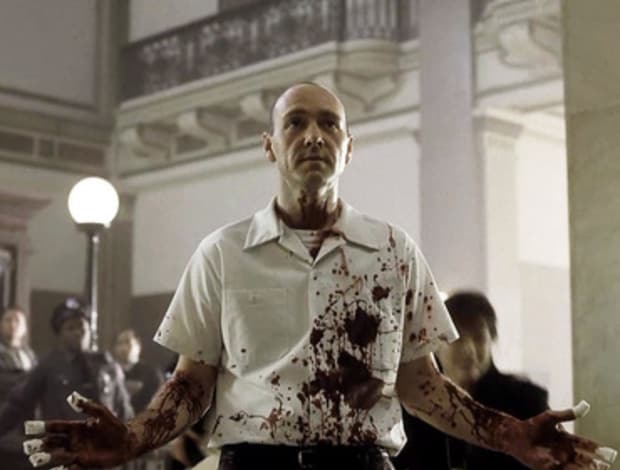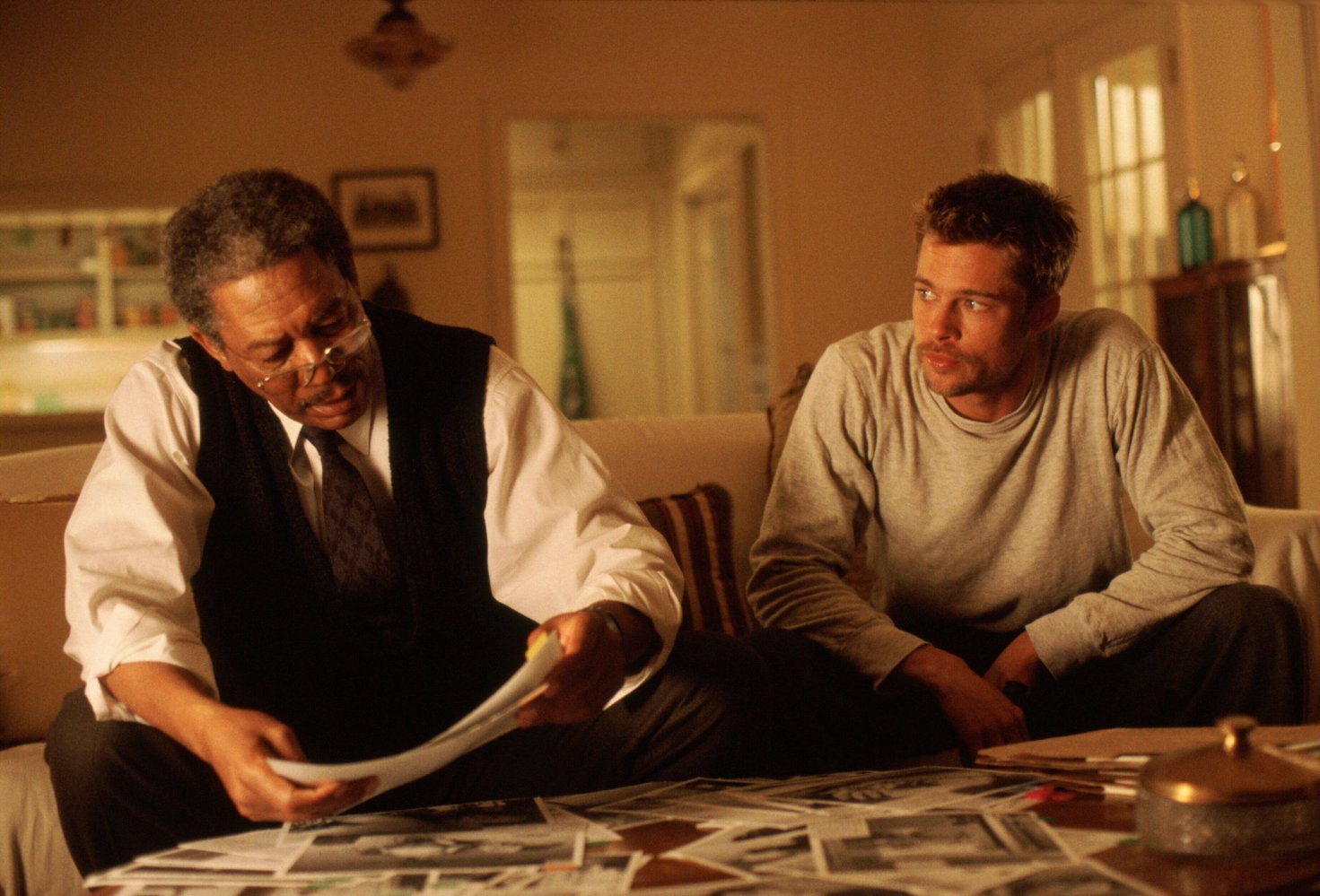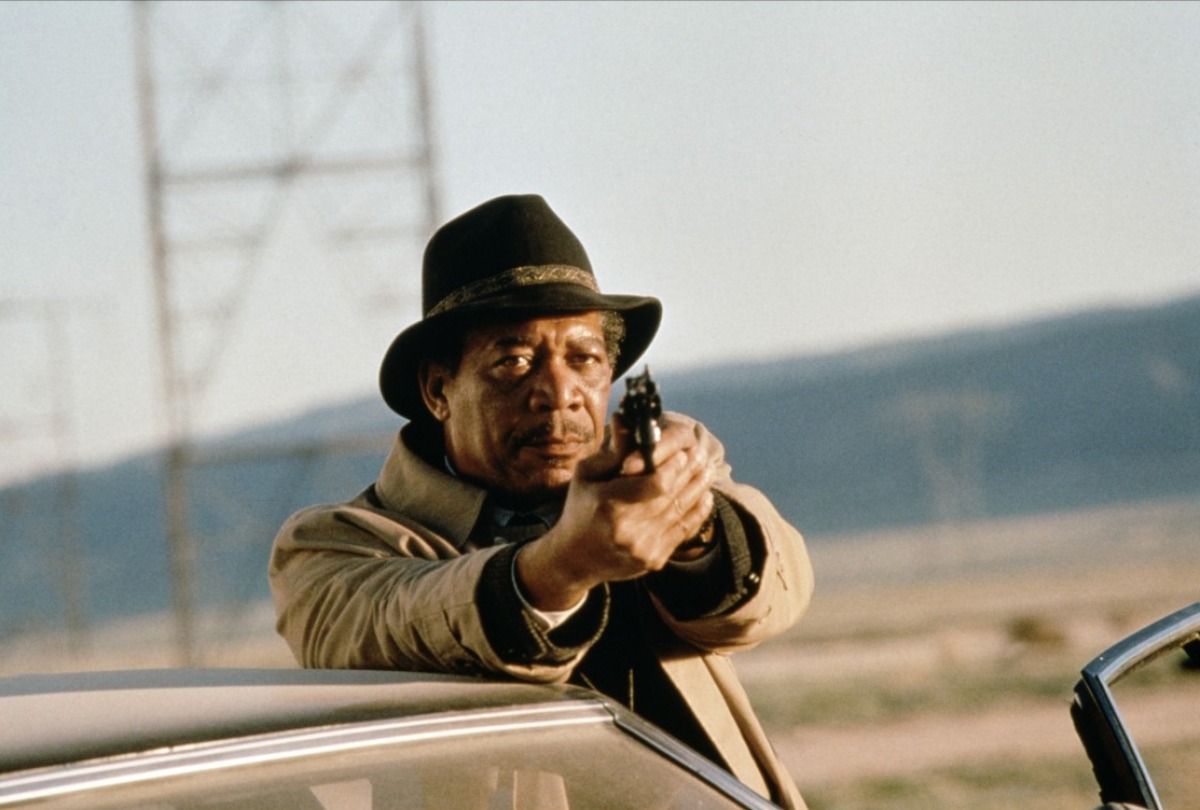4. “Se7en” truly has a villain to remember

For a hero or agent of good to be effective, that character must have a villain worthy of their efforts. For many, the villain of “Se7en” rates right at the top of film history’s all-time most memorable. Know only as ‘John Doe’, he is not as colorful or quotable as, say, Hannibal Lecter or Norman Bates.
If he were a real human being he would be far less like Charles Manson and more like Ted Bundy, a deceptively bland monster. Quite often in films of this genre, there is usually a big scene where the killer tells the police and/or next potential victim all about what got them so messed up (childhood gets brought up quite a bit in these scenes).
‘John Doe’ is modeled more after director Fritz Lang’s treatment of the serial killer in his 1931 classic “M”. While a few details are supplied, the killer and his ‘why’ quotient are largely left blank. This is wise for, in the end, what does it matter what twisted the man and why he set off on his course (unless the film was intended as a psychological study of such a character)?
In this film, the man is quite cunning. He has obliterated his identity to the point where the police cannot begin to discover who he really is and from where he originated (though, disturbingly, they can tell that he is, incongruously, an educated man from what seems to be a moneyed background). Freeman’s character is only able track down the killer’s macabre lair by resorting to an illegal tactic (calling in a favor and being allowed to examine library book check-out records!).
When the killer calmly presents himself at the police station at the film’s two-thirds mark, the event is somehow deeply unsettling and rightly so. He has very precisely arranged things just as he wished. He has no desire to save himself and, in fact, unbeknownst to the police, has just committed the terrible crime which will make the events in the final act all but inevitable.
Just as the casting of Freeman as the force of good aided immeasurably, the casting of Kevin Spacey as ‘John Doe’ is one of the film’s high spots. Spacey is one of the modern acting profession’s best creeps. Has he ever played a normal, virtuous, good character? If so, surely no one remembers it.
The same year “Se7en” premiered he won his first (and, by far, more deserving) Oscar for what might well be an even more memorable villain in the thriller “The Usual Suspects” (a good film but lacking Se7en’s ability to hit a deeper nerve).
However, it’s quite possible that Academy voters also remembered “Se7en” while voting for his work in the other film. He was so dedicated to the role and film that he volunteered to have his name left out of Se7en’s ultra-stylish, much commented-on opening credits and saved until the end, so that his appearance would be surprising (and this actually works better today since he wasn’t that well known at the time).
The calm assurance Spacey brings to the character on top of his great ability to suggest the dreadful creature under the drab façade makes ‘John Doe’ one of the most truly scary of movie villains.
5. “Se7en” makes a convincing case for normality

For the battle of the forces the senior detective and the oblique villain represent to have any real meaning or weight, then something has to be shown as being at stake. In the case of “Se7en”, this turns out to be the young detective assigned to replace the retiring man and the detective’s angelic school teacher wife.
The young woman also confides in the older man that she is pregnant with the couple’s first child, but is afraid of telling her beloved husband during a time so filled with stress for him, one which is making him question bringing children into such a world.
In a usual film, the older man would probably die (more than likely saying something about the beautiful place he won’t get to now retire to as he breathes his last breath) while the young people receives a moral lesson and know that they must find the courage to live and carry on the man’s work.
This is not that film. The pair are shown as good but quite deliberately unexceptional. The young man surely is dedicated to his job and is vigorous in his pursuit of justice (although this leads to a truly terrible irony), but he is still callow and doesn’t know the angles and, as it turns out, can’t roll with the (admittedly awful) punches.
The wife, who should be, but sadly isn’t, tangential to the main plot, is just shown wanting a conventional family life and is seen as deeply loving. If they weren’t such basically fine and likeable people then the finale would not have the tremendous punch it packs. In all honesty, these are not difficult roles (though they are crucial), requiring just the right casting in the manner of the previously discussed character.
However, it must be pointed out that Brad Pitt and Gwyneth Paltrow, then famously a couple and near the beginning of their film careers, fill out the roles quite well. Pitt has made a habit (usually with memorable results) of playing against his extraordinarily good looks and digging deep into quirky, often grimy characters.
This role was pretty much before that. He must play an ordinary, nice young husband and an agent of law and order. Paltrow seems to have fallen from grace in recent years (her rather dubious Oscar win looks to have cursed her since she’s rarely done anything decent since), but she was poised to be the new ‘it’ girl of the movies and a promising young actress.
Frankly, her work here shows more promise than was fulfilled later. She only has a small amount of screen time but must make an impact or the finale won’t really work at all. In this film she comes through just fine. (If one wished to be snarky, though, many who have since come to dislike this actress may now regard “Se7en” as having the happiest ending of any of her films.)
6. The setting and the imagery are flawless

Like many thrillers, “Se7en” has an urban milieu. However, the unnamed city has a disturbing character all its own. One big and commented-on detail is that heavy rain is falling virtually all during the week of the film’s action (and it turns out to be an ominous sign that the finale, per the direction of ‘John Doe’,, takes place in a desolate patch of countryside and the sun happens to be finally shining).
Yes, this is done for dramatic effect, but it’s not unrealistic. If the city were in rainy place such as Seattle or Portland, especially during the right season, it is entirely possible for heavy rain to be coming down for such a long period (something about this detail bothered many at the time of the film’s release).
This makes the city quite gloomy and appropriately so for the story’s sake. However, the city also seems to be in a state of urban drift and a lot of it seems to be in an advanced stage of decay. This is obviously mirroring the moral decay which seems to reign in this benighted place, even over and above the killer’s activities. This is pointed out by the crimes themselves, which seem perfectly at home in such a setting.
Fincher is extremely adept in his presentation of the crimes. The first, gluttony, is presented is a dark apartment where the electricity has been disabled. By the police flashlights, the viewer can only see the tableaux (an obese man tied up and literally forced to eat himself to death) in snatches.
Later, the one for greed is presented in pictures the police detectives are asking the victim’s wife to look at in hopes of finding some crucial detail. The pictures have tape covering insensitive parts, which somehow makes them even more disturbing, especially in light of the wife’s sadly hysterical crying while being forced to view them.
Even worse is the tableaux for lust, which was staged in a massage parlor and not shown to the viewer. It involves a specially created implement which brings death in a spectacularly unpleasant manner during sex and which is also shown in a police photo.
The police track down maker of the implement and also question a worker at the massage parlor, both of whom maintain that they only do what they are paid to do without questions. Obviously, they, like many in the city, live in an amoral sphere. Somehow, this all seems even more frightening than ‘John Doe’.
7. The grand finale

Now we discuss an event alluded to throughout this article. If all the elements leading up to a film’s ending are good, then the ending shouldn’t affect all of that so much. Conversely, a good ending shouldn’t make a bad film seem good, right? In theory this is correct, but in practice it doesn’t often work out that way.
Hitchcock and several film historians long maintained that 1941’s “Suspicion” was ruined by a studio-imposed happy ending. The interesting and decidedly not bad ending of the Oscar-winning “No Country for Old Men” left many flat since it was so out of left field (more misinterpreted than anything else).
However, “Se7en” is a strong film and it needed a strong finale to drive that home. If there had been some sort of daring rescue (likely involving the high ledge of a rain-slicked building, as in many such films), then much of the power would have been dissipated.
When Freeman’s character opens the ominous cardboard box ‘John Doe’ has had delivered to the barren patch of country and, for the one and only time, registers shock and then calls his superiors exclaiming that the villain has won (literally), the viewer knows that the universe must have gone out of order… and it has.
One of the worst things imaginable has already taken place, as it turns out, and all the detective can do is try to do damage control before even worse follows. Sadly, even this turns out to be beyond his control.
Filmmakers and production companies are, and have always been, afraid of unhappy endings. There may well be good reasons for this since often viewers may steer clear of films that end tragically.
However, this is overlooking the fact that some films only make sense, much less have any real power in their telling, if they follow their logical course to an unhappy ending. Director Roman Polanski famously prevented his 1974 classic “Chinatown” from being given a semi-happy ending over the devastating one which helped make it a classic.
Here, Fincher prevented a more conventional happy ending from ruining this film (though the original ending was even more tragic and he had the sense to pull back just a bit after the adverse reaction of preview audiences to it). “Se7en” is remembered by many and its ending is remembered most of all. As stated, if Fincher and company hadn’t created such a memorable film up to that point, the potent ending wouldn’t have saved it but, as it happened, this ending crowned a great effort.
Author Bio: Woodson Hughes is a long-time librarian and an even longer time student/fan of film, cinema and movies. He has supervised and been publicist for three different film socieities over the years. He is married to the lovely Natalie Holden-Hughes, his eternal inspiration and wife of nearly four years.